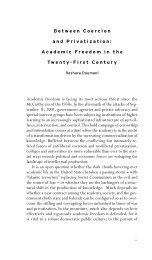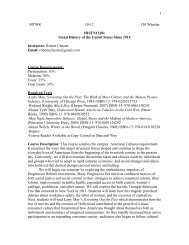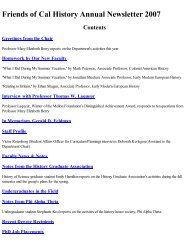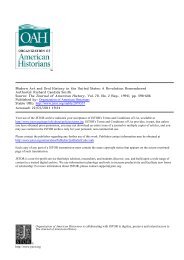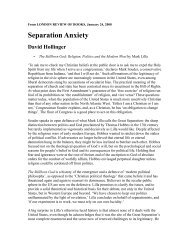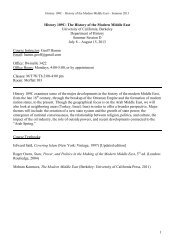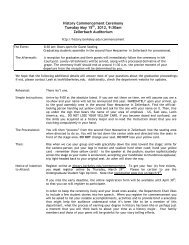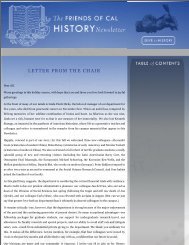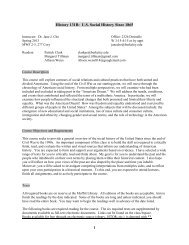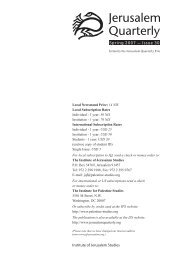David A. Hollinger | Amalgamation and Hypodescent: The Question ...
David A. Hollinger | Amalgamation and Hypodescent: The Question ...
David A. Hollinger | Amalgamation and Hypodescent: The Question ...
Create successful ePaper yourself
Turn your PDF publications into a flip-book with our unique Google optimized e-Paper software.
Yet when we look at the statistics, we cannot fail to notice that the rate of black-white marriage is 52now considerably greater—several times greater—than the rate of Jewish-gentile marriage only sixtyyears ago. And we need to remember that not everyone who cohabits <strong>and</strong> reproduces gets married. <strong>The</strong>percentage of the American population—white <strong>and</strong> black, <strong>and</strong> even yellow <strong>and</strong> brown <strong>and</strong> red—that isgetting married at all is diminishing. Non-marital cohabitation across ethnoracial lines is generallybelieved to be even more common than marriage across ethnoracial lines, but the data is less definitive.Even so, the extent of ethnoracial mixing registered in the marriage statistics of the federal censuses 53of 1990 <strong>and</strong> 2000, taken together with the growing willingness to accept as real the black-white mixing—including that created by the massive rape of slave females—that has gone into the genetic making ofthe African-American population, invites us to see the history of the United States as, among otherthings, a story of amalgamation, however episodic <strong>and</strong> however given to the greater bonding of someelements than others. To speak of "amalgamation" as a major theme in U.S. history is to reclaim thevocabulary of Wendell Phillips <strong>and</strong> Frederick Douglass <strong>and</strong> Ralph Waldo Emerson, to renounce the JimCrow distinction between miscegenation <strong>and</strong> the melting pot, to integrate the story of black-whitemixing with the story of other kinds of mixing, to escape the implications of Anglo-conformity oftenhistorically associated with the figure of the melting pot, to recognize a dynamic interaction notcaptured by the more limited concept of assimilation, <strong>and</strong> to deny at long last the legitimacy of theprinciple of hypodescent.<strong>Amalgamation</strong> in the history of the United States has been episodic <strong>and</strong> segmented. Not every tribe 54in the United States has mixed equally with each other, or at the same pace, or with equal agency, orhas faced the same obstacles <strong>and</strong> inhibitions <strong>and</strong> incentives <strong>and</strong> disincentives. Not every mixture hashad an equal impact on the whole. Hence the old myth of the melting pot is at once deeply false <strong>and</strong>deeply true. To confront these features of the process of amalgamation <strong>and</strong> to underst<strong>and</strong> the specificrole played in that process by hypodescent racialization is to integrate the story of physical mixing withthe story of racism <strong>and</strong> anti-racism. It is a mistake to treat these two narratives as rivals, with the storyof physical mixing allowed to license political complacency ("We don't need policies to deal with theeffects of racism, because we can just let nature take its course"), <strong>and</strong> the story of racism <strong>and</strong> antiracismallowed to license calls for struggle ("We must mobilize to defeat racism"). <strong>The</strong> greateracceptance of descent mixture in our own time is obviously a result of the political struggle that hasdiminished racism in the United States. Its emergence cannot be explained apart from that struggle forethnoracial equality.<strong>The</strong> national experience with intimacy across ethnoracial lines has been one of amalgamation 55interruptus: irregular, stutter-step, tension-filled, <strong>and</strong> sometimes violent, <strong>and</strong> thus quite different fromthe spontaneous, relatively relaxed intimacy leading to closure so often celebrated under the sign of themelting pot. But it has been amalgamation nevertheless, <strong>and</strong> on a scale <strong>and</strong> within a time frame thatgives it a strong claim to being one of the central features of the history of the United States whenviewed in comparative perspective. A number of other nations have experienced large measures ofmixture. Brazil, Argentina, South Africa, New Zeal<strong>and</strong>, <strong>and</strong> Canada are prominent examples, each withits own history of our question deserving of the world's attention. But the United States is at least animportant case in which a large number of descent groups deriving from a great range of points oforigin have blended. If demographic mixture is a theme more prominent in the modern history of theWestern Hemisphere than of the Eastern, the amalgamation narrative foregrounds the features of theUnited States that most make it an "American" nation rather than an expansion of a Europe in whichnationality <strong>and</strong> descent continue to go together more often than not. 74This mixture-centered view of the history of the United States contrasts vividly with what is at once 56the most Western Hemisphere–preoccupied <strong>and</strong> the most conspicuously census-inspired of allinterpretations of American history, the frontier thesis. Frederick Jackson Turner developed thisinterpretation on the basis of the census of 1890 finding that what had been the territory beyond whitesettlements was now made up of organized counties with enough people in them to be enumerated in



